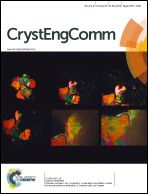Ln–Cd heterometal organic–inorganic hybrid materials based on diverse Ln–Cd oxo-cluster chains: syntheses, structures and visible luminescence†
Abstract
Three novel Ln–Cd heterometal organic–inorganic hybrid materials, [LnCd(phen)(ox)1.5(SO4)(H2O)2]·H2O (type I: Ln = Sm 1a; Eu 1b; phen = 1,10-phenanthroline; H2ox = oxalic acid) and [EuCd2(Meimdc)2(Ac)(H2O)2]·H2O (type II: 2; H3Meimdc = 2-methyl-imidazole-4,5-dicarboxylic acid; HAc = acetic acid) have been successfully synthesized under hydrothermal conditions. The type I compounds are the first examples of Ln–Cd heterometal organic–inorganic hybrid sulfate–carboxylates with a lattice bilayer structure. The extended structure of type II consists of EuCd(Meimdc) and Cd2(Meimdc) helices cross-linked through Ln–Cd oxo-cluster chains, showing a 3D microporous architecture with left-/right-handed helical tubes (L1/R1) and channels (L2/R2) along the b axis. The luminescence properties of complexes 1b and 2 exhibit the characteristic emission bands of Eu3+ ions. The photoluminescence spectra of 1b and 2 show characteristic line-splitting at room temperature, depending on the site-symmetry of Eu3+ ions in the complexes.


 Please wait while we load your content...
Please wait while we load your content...